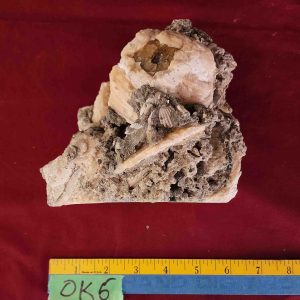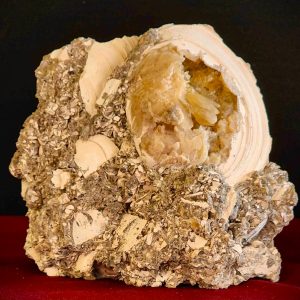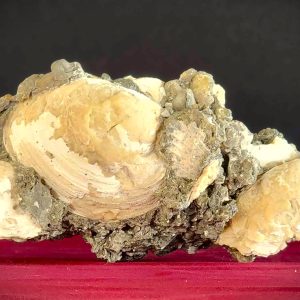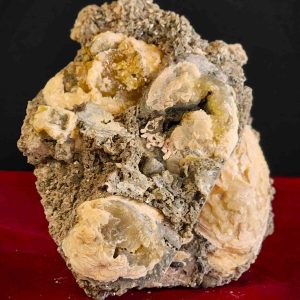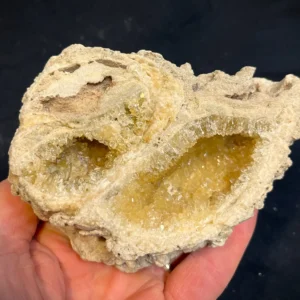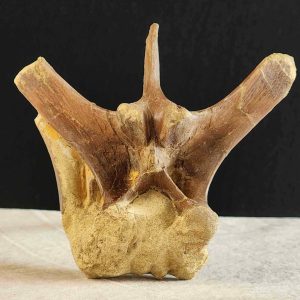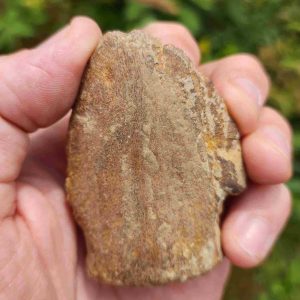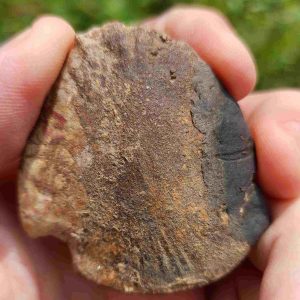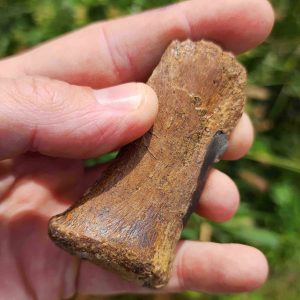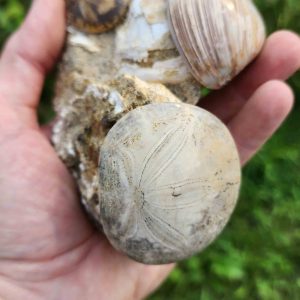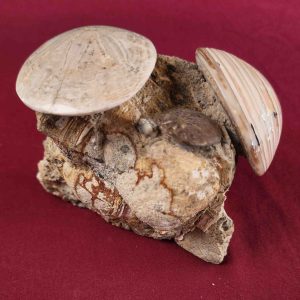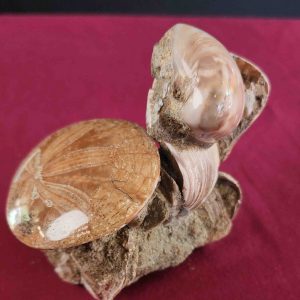All Products
-
Crystalized Clam (OK6)
Crystalized fossil clams like this are exceptionally rare. These clams lived in a shallow sea that covered most of Florida 2 million years ago. A sudden storm event buried the clams, trapping cavities inside. When the shells began to dissolve, it provided the material necessary to grow calcite crystals in the open spaces. These unusual fossils are known from only one site, an old quarry near Lake Okeechobee. The quarry played out and flooded in 2007. We excavated this in 2023. An attractive and informative display card accompanies the specimen.
Notes specific to this specimen: Great honey calcite crystals replacing multiple clam shells trapped in matrix. This piece has a sawn flat bottom so it stands up nicely on its own
SIZE: 7″x 4″x 5″
NAME: Mercenaria permagna
AGE: Pleistocene 2 million years
UNIT: Nashua Formation
SITE: Okeechobee County, FloridaDocumentation: This authentic fossil specimen comes with a Certificate of Authenticity and Origin. In addition, an attractive and informative display card accompanies the specimen.
$410.00Crystalized Clam (OK6)
$410.00 -
Crystalized Clam (OK7)
Notes specific to this specimen: Great honey calcite crystals replacing one clam shell trapped in matrix. Some excellent radial calcite crystals are on this piece as well.
SIZE: 7″x 5″x 7″NAME: Mercenaria permagna
AGE: Pleistocene 2 million years
UNIT: Nashua Formation
SITE: Okeechobee County, FloridaDocumentation: This authentic fossil specimen comes with a Certificate of Authenticity and Origin. In addition, an attractive and informative display card accompanies the specimen.
$310.00Crystalized Clam (OK7)
$310.00 -
Crystalized Clam (OK8)
Notes specific to this specimen: Calcite replacing multiple clam shells trapped in matrix, some with clearly defined crystals. One of these is a full clam with crystal zones evident.
SIZE: 11″x 5″x 5″
NAME: Mercenaria permagna
AGE: Pleistocene 2 million years
UNIT: Nashua Formation
SITE: Okeechobee County, FloridaDocumentation: This authentic fossil specimen comes with a Certificate of Authenticity and Origin.
$280.00Crystalized Clam (OK8)
$280.00 -
Crystalized Clam (OK9)
Notes specific to this specimen: Lots going on here: Three shells with shiny nice dogtooth calcite crystals trapped in matrix. Plus a superb large shell with great recrystallization.
SIZE: 9″x 8″x 5″
NAME: Mercenaria permagna
AGE: Pleistocene 2 million years
UNIT: Nashua Formation
SITE: Okeechobee County, FloridaDocumentation: This authentic fossil specimen comes with a Certificate of Authenticity and Origin. In addition, an attractive and informative display card accompanies the specimen.
$385.00Crystalized Clam (OK9)
$385.00 -
Crystalized Welks (W1)
Notes specific to this specimen: At our Rucks Pit site we sometimes come across fossil welks (conchs). On rare occasions they may be crystalized. This one has been cut in half to show the great crystal-lined hollow section inside. Rare find.
SIZE: 5″
NAME: Mercenaria permagna
AGE: Pleistocene 2 million years
UNIT: Nashua Formation
SITE: Okeechobee County, FloridaDocumentation: This authentic fossil specimen comes with a Certificate of Authenticity and Origin. In addition, an attractive and informative display card accompanies the specimen.
$480.00Crystalized Welks (W1)
$480.00 -
Dinosaur Bones (D1)
Notes specific to this specimen: This is a very well preserved neural arch and process of a cervical vertebrae, probably about midway down the neck of a hadrosaur (bipedal) dinosaur. The centrum is not present. The fine detail on the bone surface is exquisite and remarkably well preserved. This exceptional piece has no reconstruction.
SIZE: 5″ x 5″ x 3″
NAME: Edmontosaurus
AGE: Cretaceous Period – 68 million years
UNIT: Lance Creek Formation
SITE: Lance Creek, WyomingDATE: 1992
Documentation: This authentic fossil specimen comes with a Certificate of Authenticity and Origin.
$820.00Dinosaur Bones (D1)
$820.00 -
Dinosaur Bones (D2)
Notes specific to this specimen: Commonly called the “hoof” of a hadrosaur – in this case Edmontosaurus – this is the end bone of a pes digit (toe). In vertebrates, the ends of the front appendages are called the “manus” (aka hand) while the back are called the “pes” (aka foot). The asymmetry here indicates this was likely a toe on the right side of the animal. The fine detail on the bone surface is exquisite and remarkably well preserved. This piece has no reconstruction.
SIZE: 3″ x 2″ x 1″
NAME: Edmontosaurus
AGE: Cretaceous Period – 68 million years
UNIT: Lance Creek Formation
SITE: Lance Creek, WyomingDATE: 1992
Documentation: This authentic fossil specimen comes with a Certificate of Authenticity and Origin.
$575.00Dinosaur Bones (D2)
$575.00 -
Dinosaur Bones (D3)
Notes specific to this specimen: Commonly called the “hoof” of a hadrosaur – in this case Edmontosaurus – this is the end bone of a pes digit (toe). In vertebrates, the ends of the front appendages are called the “manus” (aka hand) while the back are called the “pes” (aka foot). The fine detail on the bone surface is remarkably well preserved. This piece has a small amount of reconstruction as shown in the dark paleoclay area.
SIZE: 3″ x 2″ x 3″
NAME: Edmontosaurus
AGE: Cretaceous Period – 68 million years
UNIT: Lance Creek Formation
SITE: Lance Creek, WyomingDATE: 1992
Documentation: This authentic fossil specimen comes with a Certificate of Authenticity and Origin.
$420.00Dinosaur Bones (D3)
$420.00 -
Dinosaur Bones (D4)
Notes specific to this specimen: This is a distal manus digit (“finger”) bone of Edmontosaurus. In vertebrates, the ends of the front appendages are called the “manus” (aka hand) while the back are called the “pes” (aka foot). The fine detail on the bone surface is remarkably well preserved. This piece has a small amount of reconstruction as shown in the dark paleoclay area.
SIZE: 3″ x 1″ x 1″
NAME: Edmontosaurus
AGE: Cretaceous Period – 68 million years
UNIT: Lance Creek Formation
SITE: Lance Creek, WyomingDATE: 1992
Documentation: This authentic fossil specimen comes with a Certificate of Authenticity and Origin.
$365.00Dinosaur Bones (D4)
$365.00 -
Fossil Sand Dollar and Clam (KH2)
Notes specific to this specimen: Matrix piece that has a flat bottom so it stands nicely. This specimen has one large and one infant sand dollar with a nice polished clam that has great colors.
SIZE: 5″x 3″x 3″
NAME: Psuedocardium & Dendraster
AGE: Pliocene Epoch – 4 million years
UNIT: Etchegoin Formation
SITE: Kettleman Hills, California
DATE: 2023Documents: This authentic fossil specimen comes with a Certificate of Authenticity and Origin. In addition, an attractive and informative display card accompanies the specimen.
$460.00 -
Fossil Sand Dollar and Clam (KH4)
Notes specific to this specimen: Beautiful and showy matrix piece with flat bottom so it stands nicely. This specimen has one large polished sand dollar and one infant sand dollar along with a great polished clam.
SIZE: 4″x 3″x 3″
NAME: Psuedocardium & Dendraster
AGE: Pliocene 4 million years
UNIT: Etchegoin Formation
SITE: Kettleman Hills, CaliforniaDocuments: This authentic fossil specimen comes with a Certificate of Authenticity and Origin. In addition, an attractive and informative display card accompanies the specimen.
$460.00 -
Fossil Sand Dollar and Clam (KH6)
Notes specific to this specimen: Exquisite large brown polished sand dollar with two great polished clams and some unpolished clams beside them. This is a matrix piece that has a flat bottom so it stands up nicely.
SIZE: 4″x 3″x 3″
NAME: Psuedocardium & Dendraster
AGE: Pliocene 4 million years
UNIT: Etchegoin Formation
SITE: Kettleman Hills, CaliforniaDocuments: This authentic fossil specimen comes with a Certificate of Authenticity and Origin. In addition, an attractive and informative display card accompanies the specimen.

